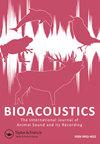Vocal repertoire of the Eurasian griffon vulture (Gyps fulvus) in the central Apennines: a baseline assessment
IF 2.1
4区 生物学
Q2 ZOOLOGY
Bioacoustics-The International Journal of Animal Sound and Its Recording
Pub Date : 2021-06-01
DOI:10.1080/09524622.2021.1925591
引用次数: 2
Abstract
ABSTRACT The Eurasian griffon vulture (Gyps fulvus) represents an exception among the European accipitrids, as it forms highly populated colonies. Although it has been the subject of many studies, social interactions and intraspecific communication are still relatively unexplored. Because of its social habits, we hypothesise that the sound language of the griffon vulture is far more complex than previously believed; the ‘Social Intelligence Hypothesis’ could in fact be relevant to this species. In this study, we took as a model the vulture population of the central Apennines (Italy), comparing the vocalisations recorded in three different locations: (i) supplementary feeding station; (ii) nesting and roosting cliffs far from anthropogenic disturbance; (iii) nesting and roosting cliffs close to settlements and roads. The results obtained by 80 monitoring hours and 20 recording hours show an articulated vocal repertoire, characterised by 12 sound categories associated with different age groups and possibly to very specific behavioural contexts. The vocal repertoire is also marked in some cases by nonlinear phenomena revealing different degrees of behavioural complexity related to the expression of emotional states and social interactions. The next steps will focus on individual recognition mechanisms and the interactions with other species sharing part of the same ecological niche.亚平宁山脉中部欧亚狮鹫(Gyps fulvus)的声乐曲目:基线评估
欧亚狮鹫秃鹫(Gyps fulvus)在欧洲鹰属中是一个例外,因为它形成了人口密集的种群。虽然它已经成为许多研究的主题,但社会互动和种内交流仍然相对未被探索。由于其社会习惯,我们假设狮鹫的声音语言比以前认为的要复杂得多;“社会智力假说”实际上可能与这个物种有关。在这项研究中,我们以亚平宁山脉中部(意大利)的秃鹫种群为模型,比较了三个不同地点记录的鸣叫声:(i)补充喂食站;(ii)远离人为干扰的筑巢和栖息悬崖;(iii)在靠近居民点和道路的悬崖上筑巢和栖息。通过80个小时的监测和20个小时的录音获得的结果显示了一个清晰的声乐曲目,其特点是12种声音类别与不同年龄组有关,可能与非常具体的行为背景有关。在某些情况下,声乐曲目也被非线性现象所标记,揭示了与情绪状态和社会互动表达相关的不同程度的行为复杂性。接下来的步骤将集中在个体识别机制和与共享同一生态位的其他物种的相互作用上。
本文章由计算机程序翻译,如有差异,请以英文原文为准。
求助全文
约1分钟内获得全文
求助全文
来源期刊
CiteScore
4.50
自引率
0.00%
发文量
25
审稿时长
>12 weeks
期刊介绍:
Bioacoustics primarily publishes high-quality original research papers and reviews on sound communication in birds, mammals, amphibians, reptiles, fish, insects and other invertebrates, including the following topics :
-Communication and related behaviour-
Sound production-
Hearing-
Ontogeny and learning-
Bioacoustics in taxonomy and systematics-
Impacts of noise-
Bioacoustics in environmental monitoring-
Identification techniques and applications-
Recording and analysis-
Equipment and techniques-
Ultrasound and infrasound-
Underwater sound-
Bioacoustical sound structures, patterns, variation and repertoires

 求助内容:
求助内容: 应助结果提醒方式:
应助结果提醒方式:


